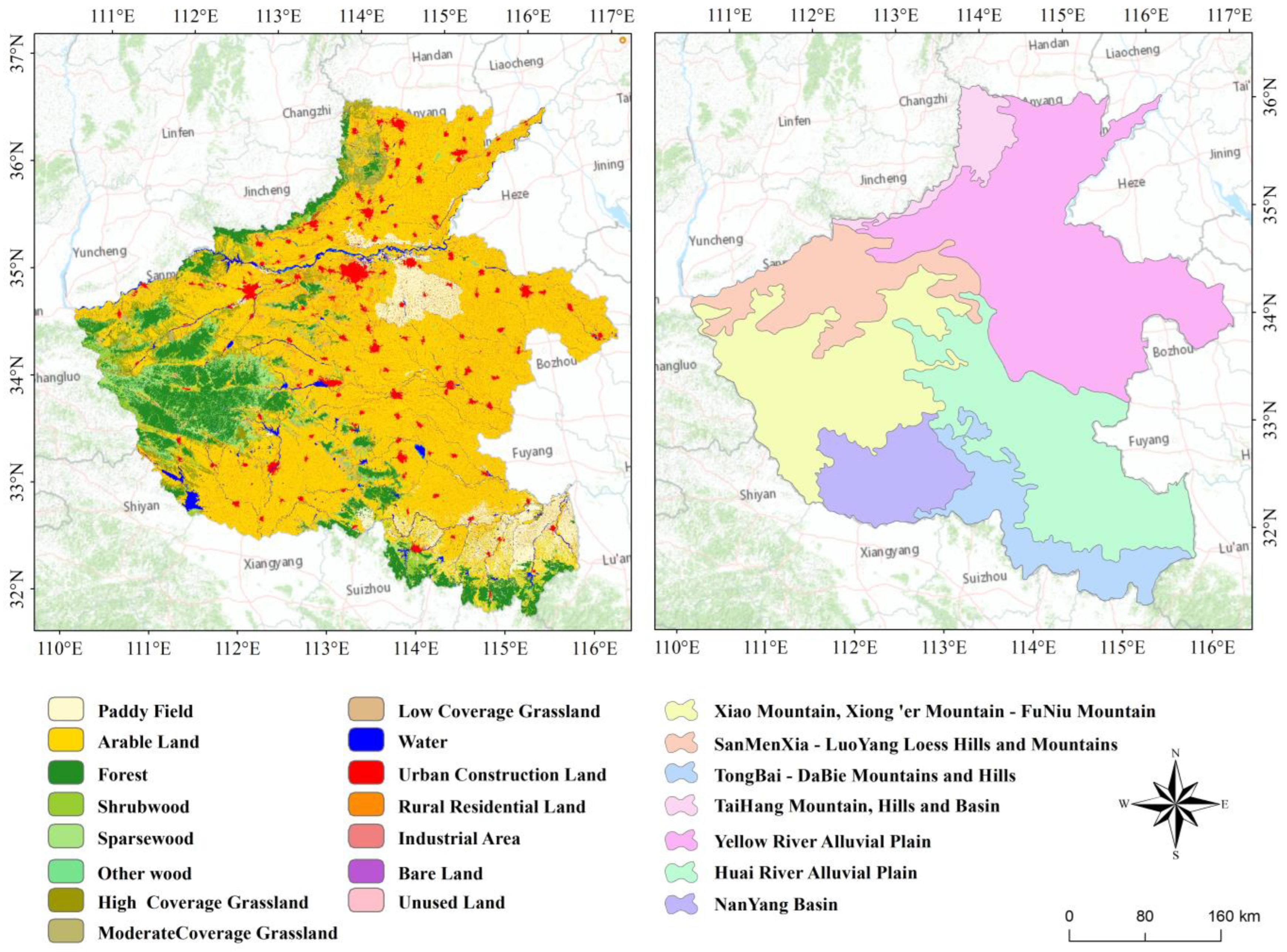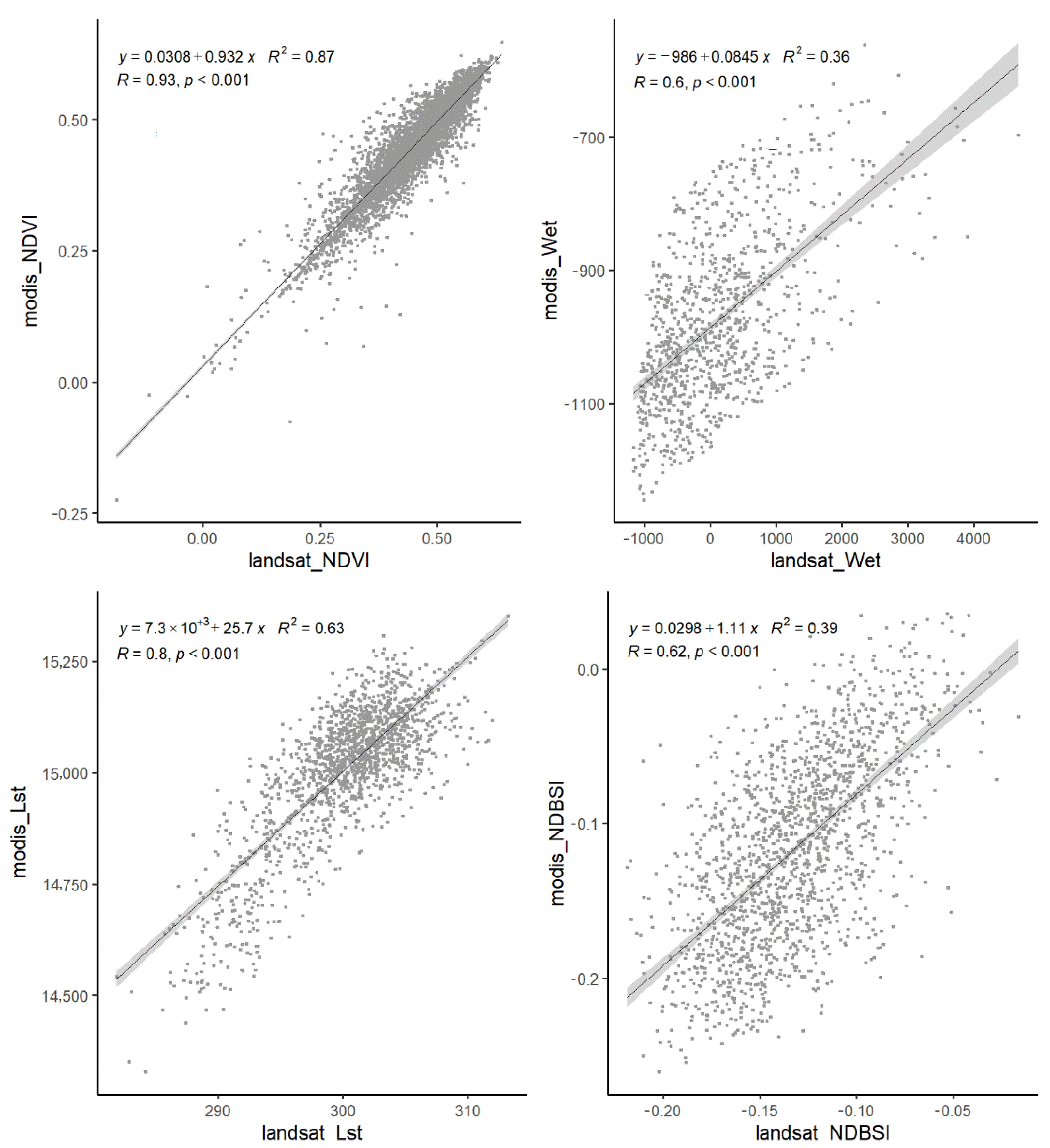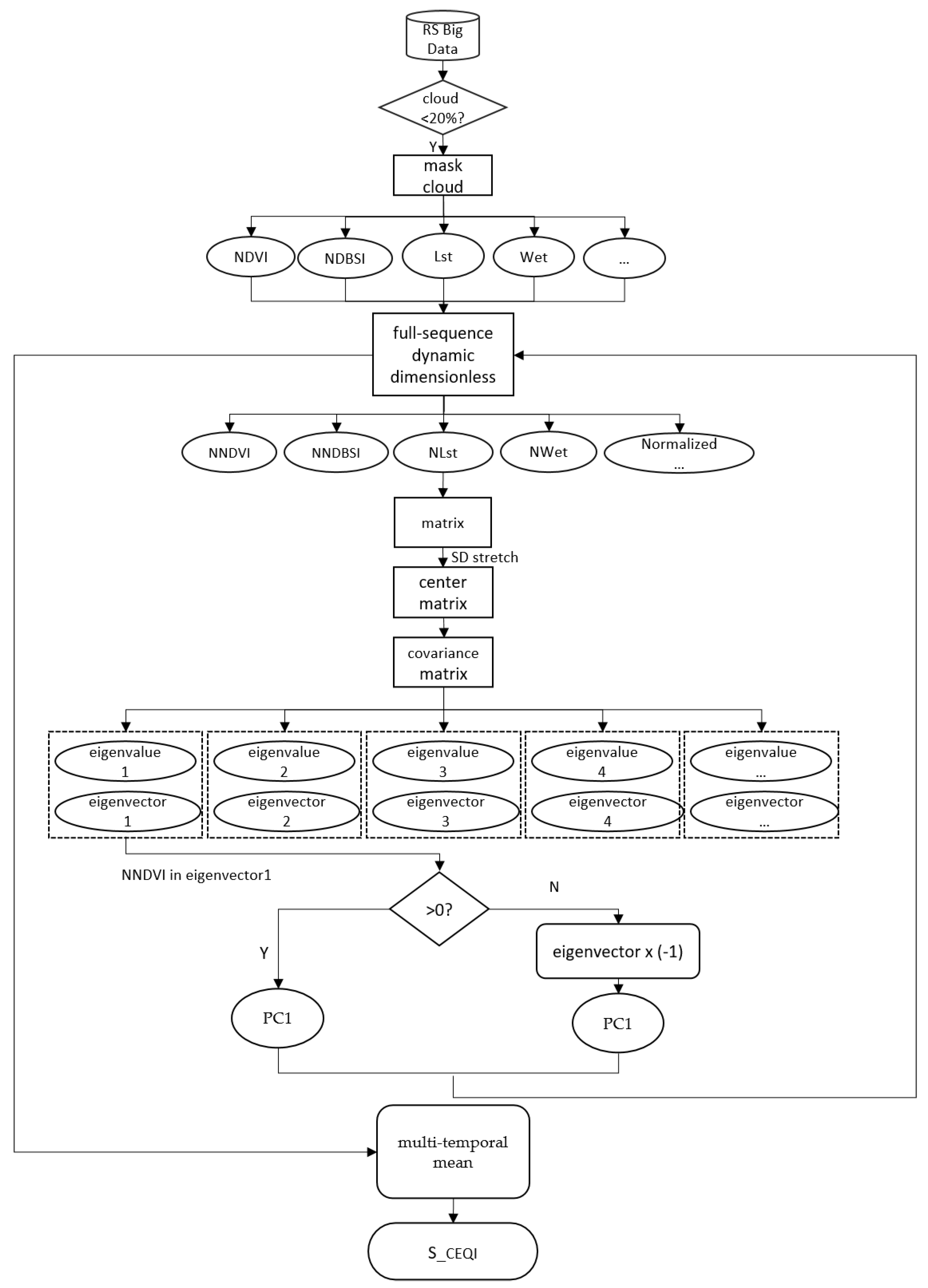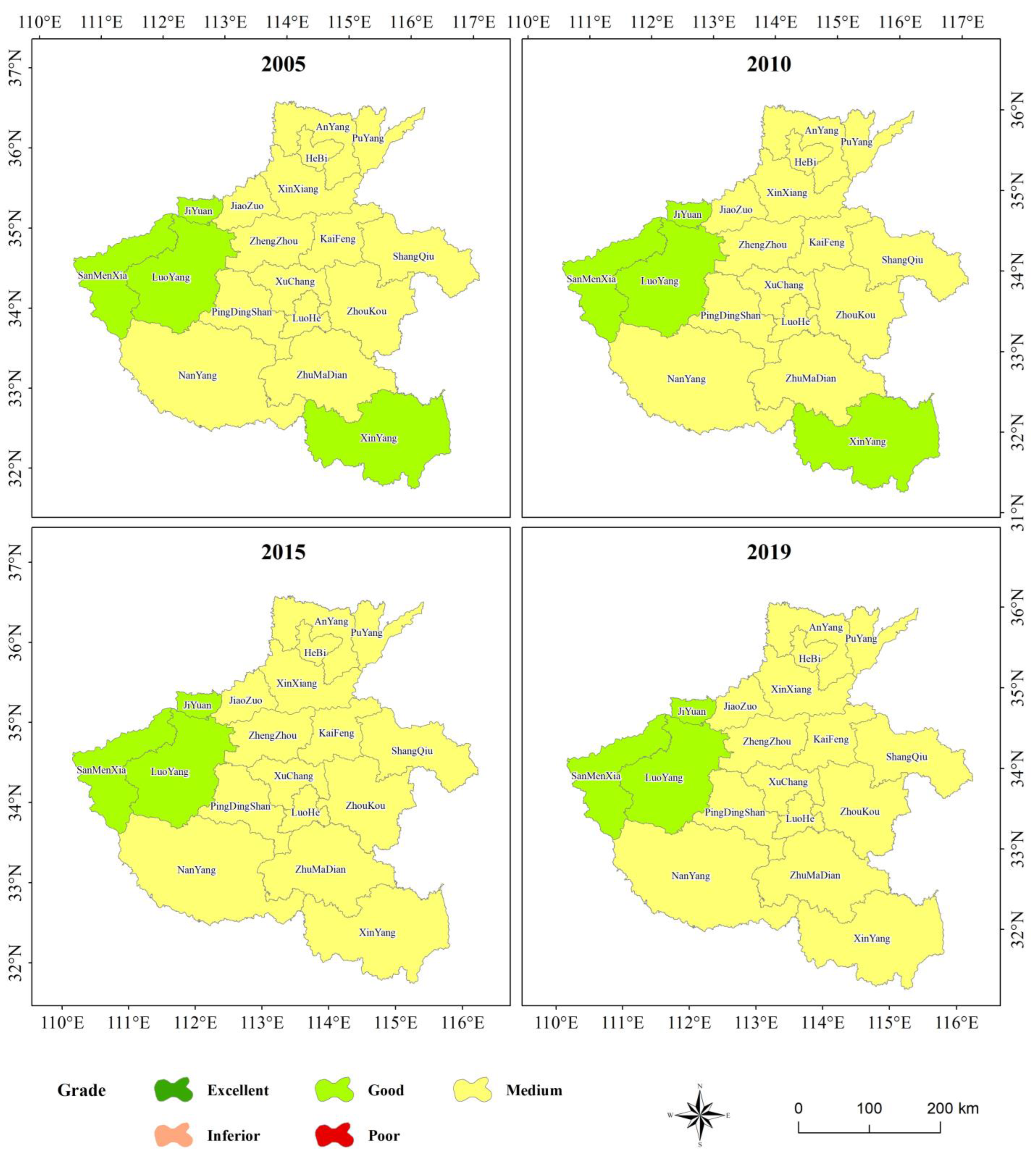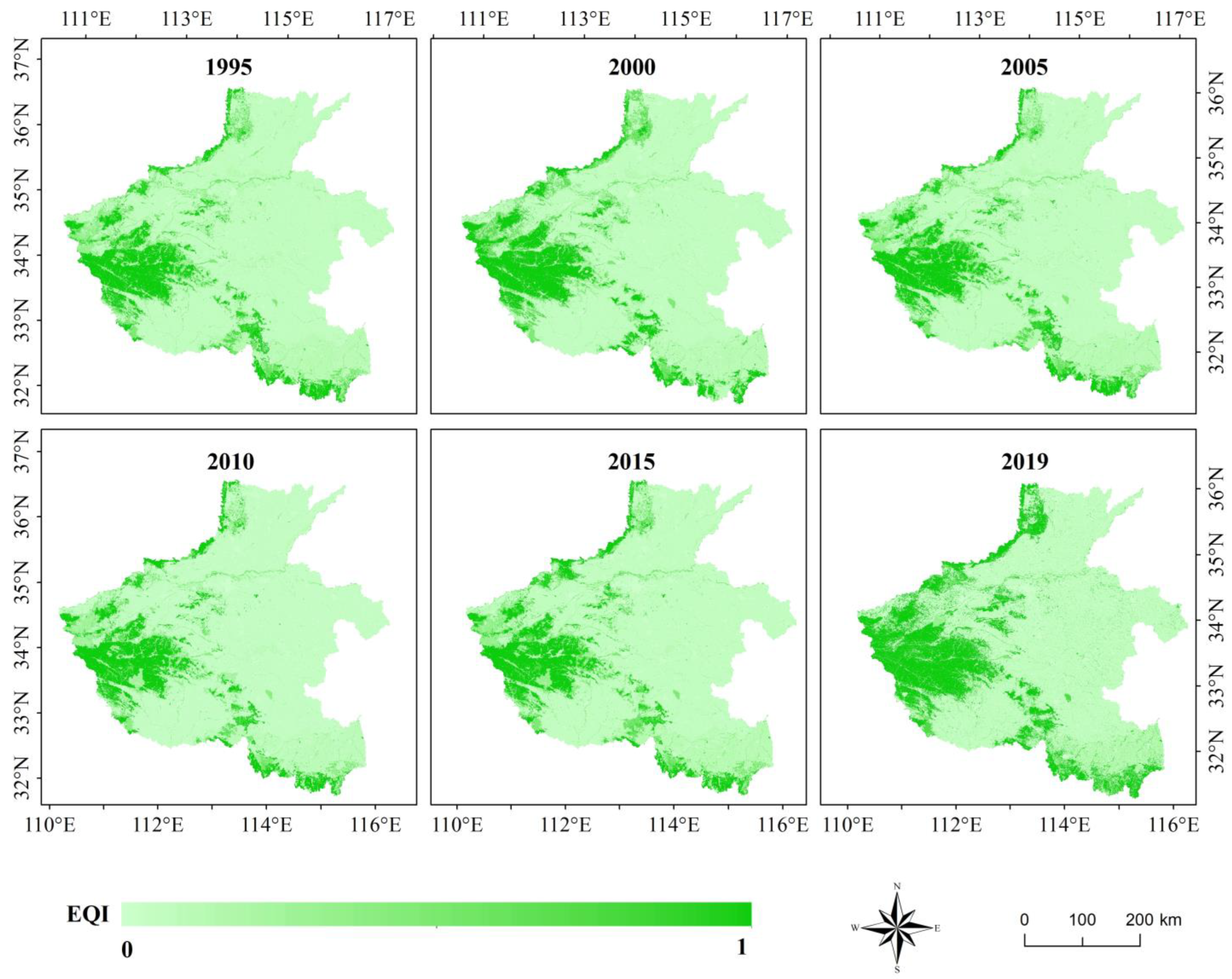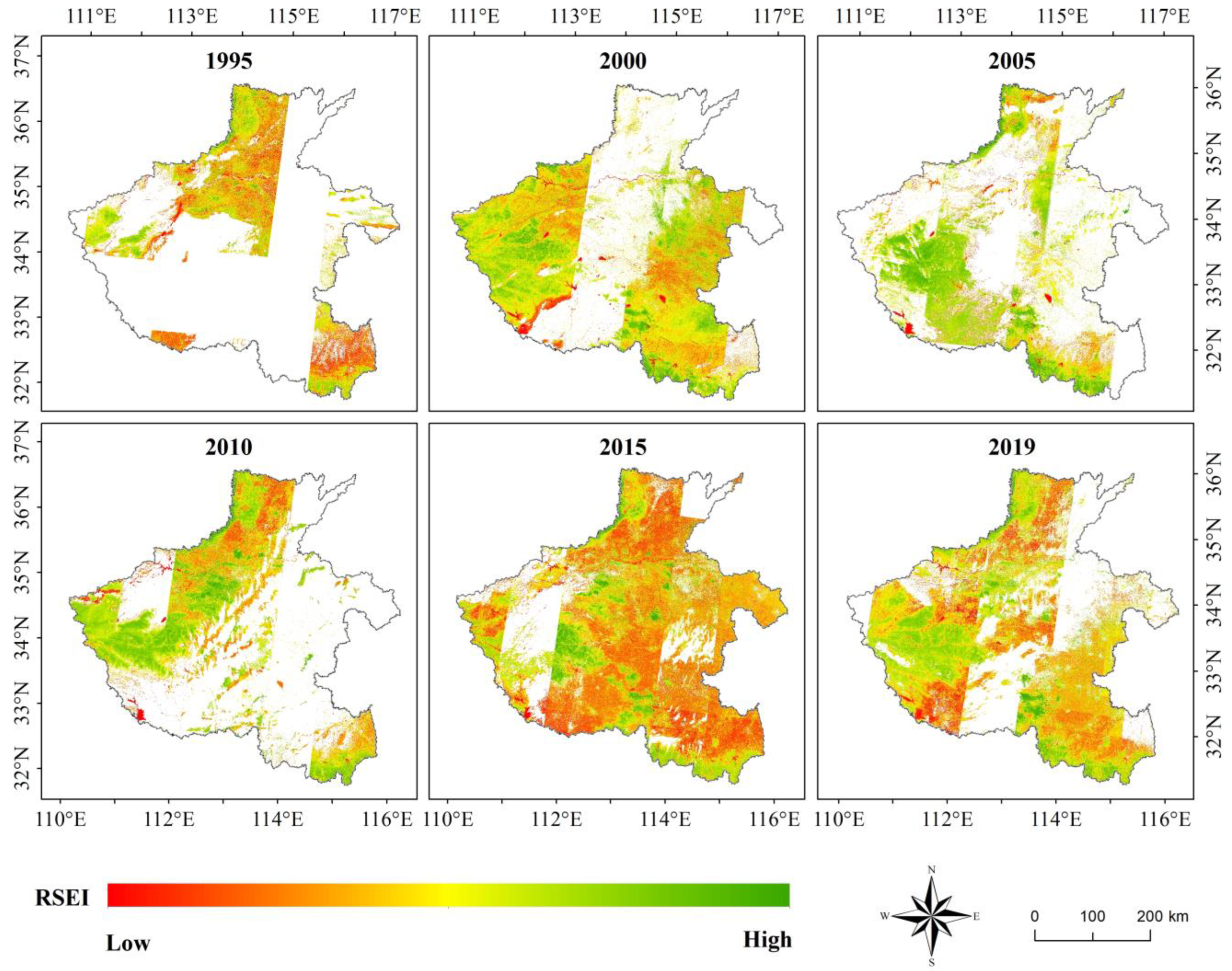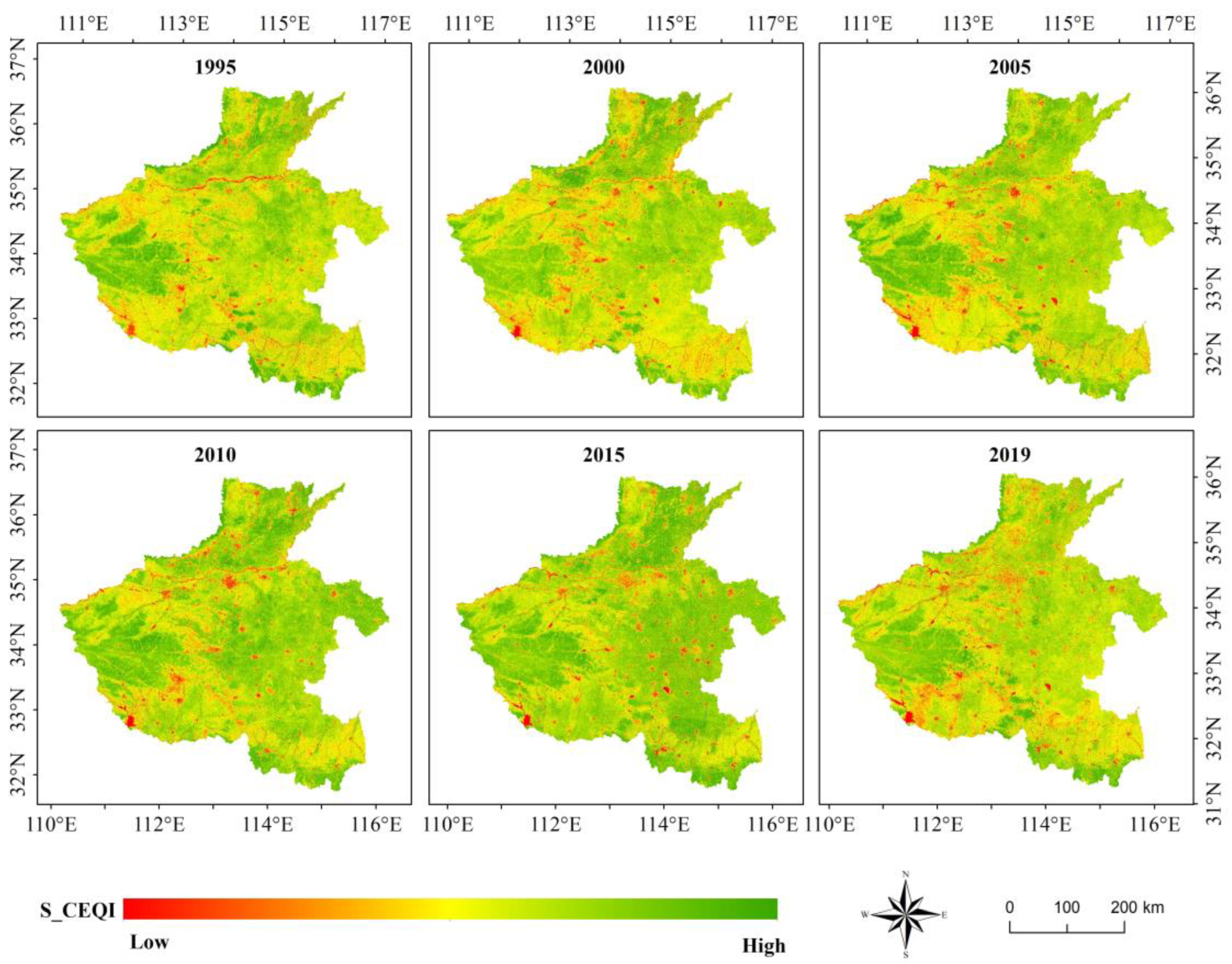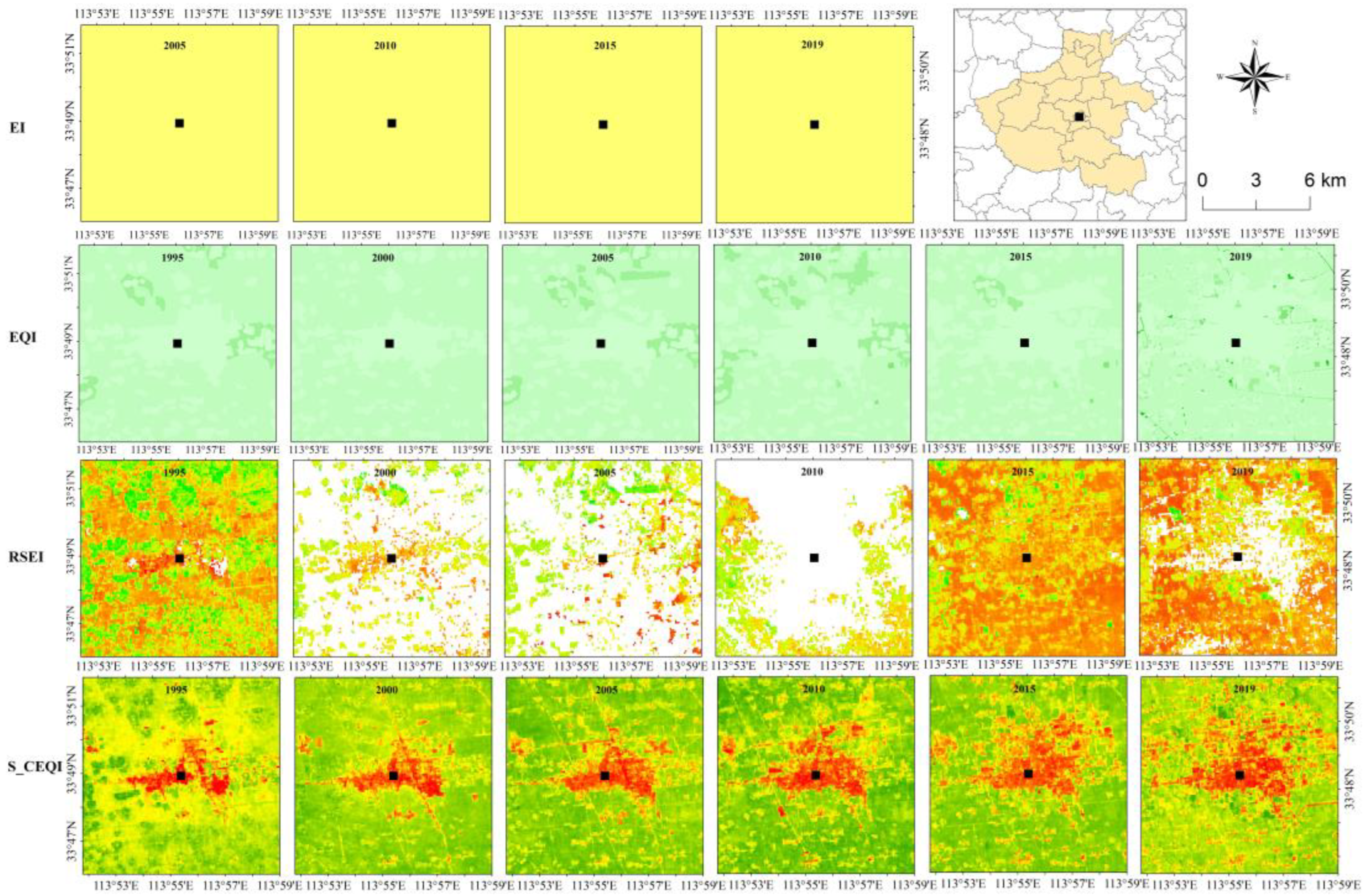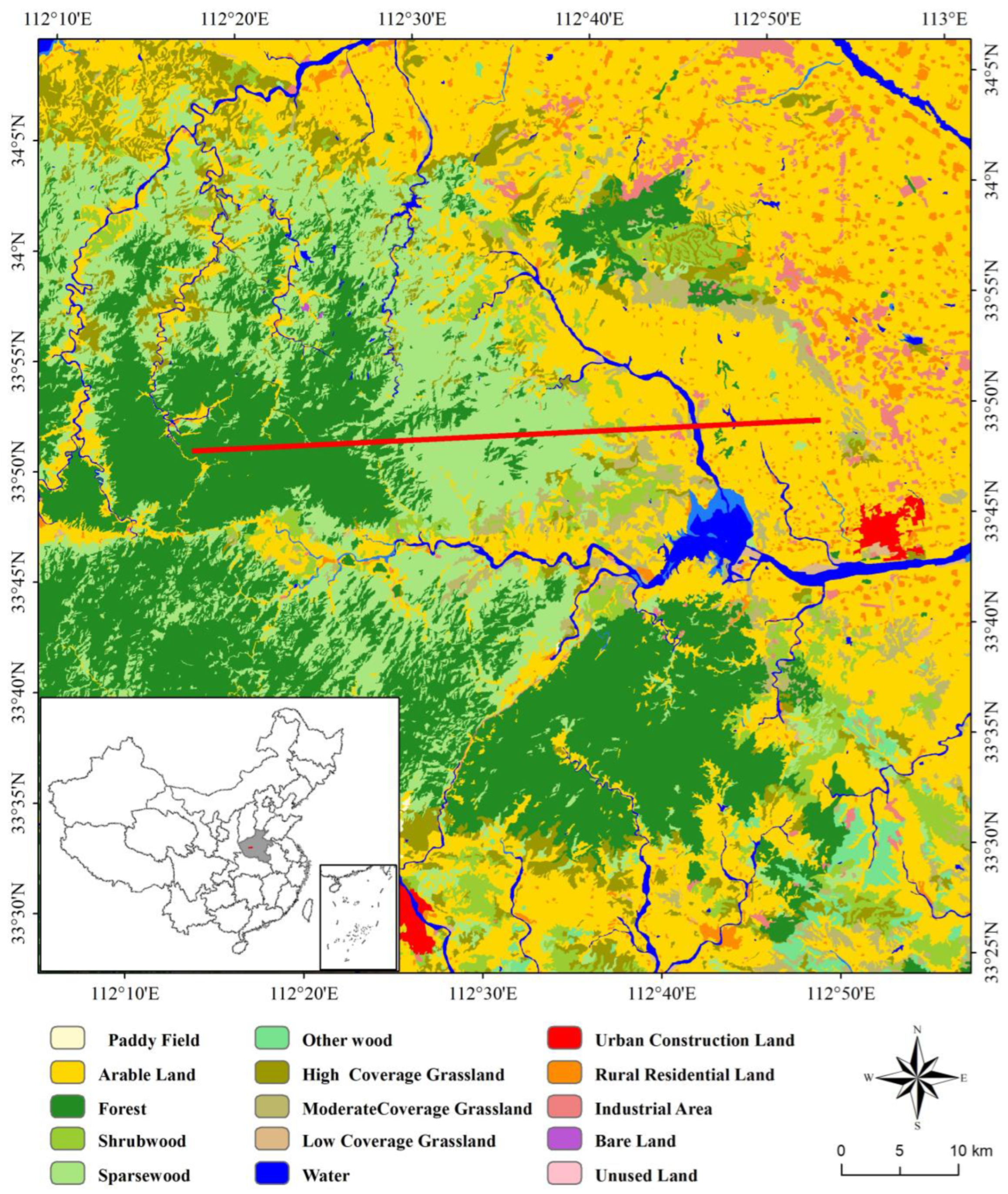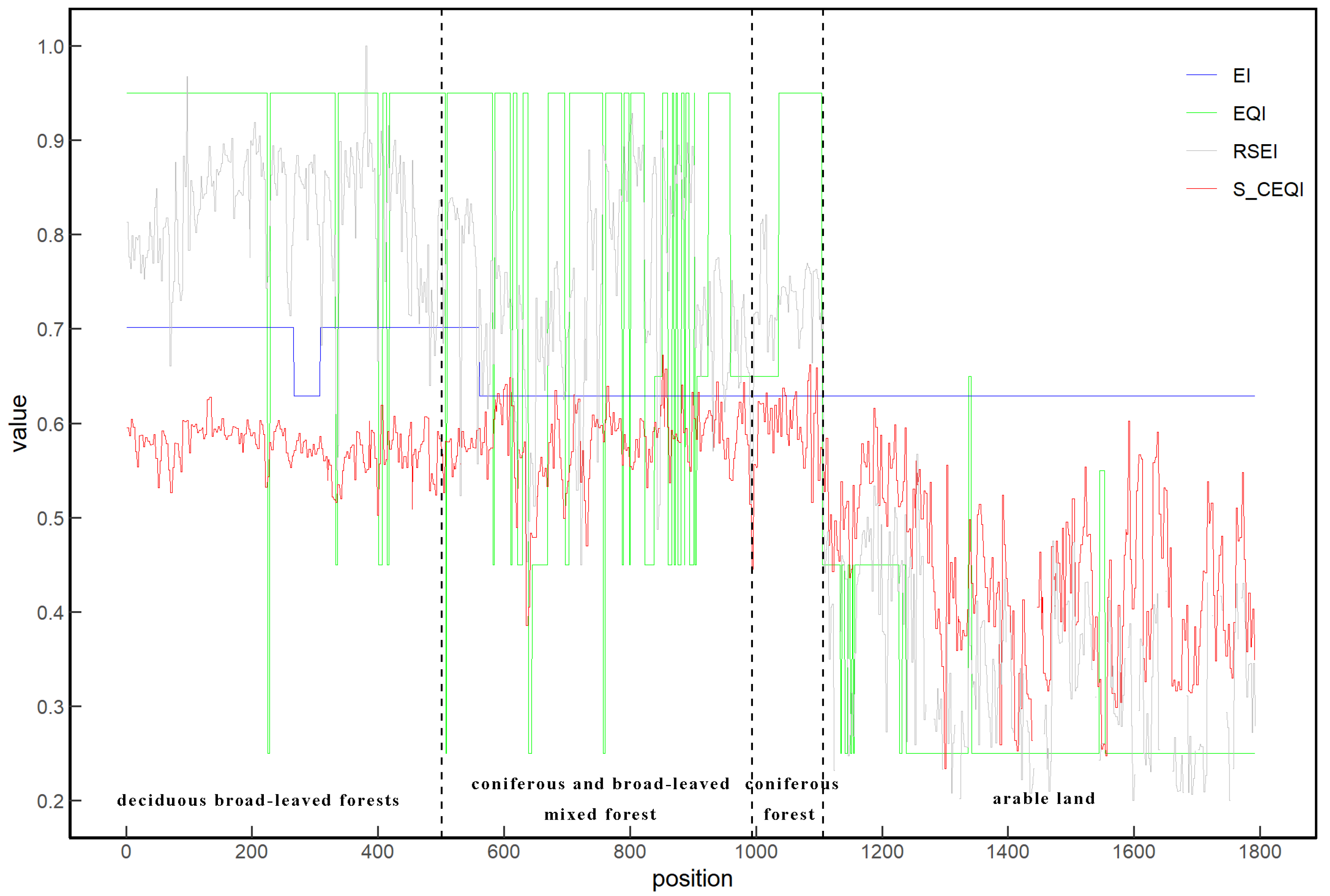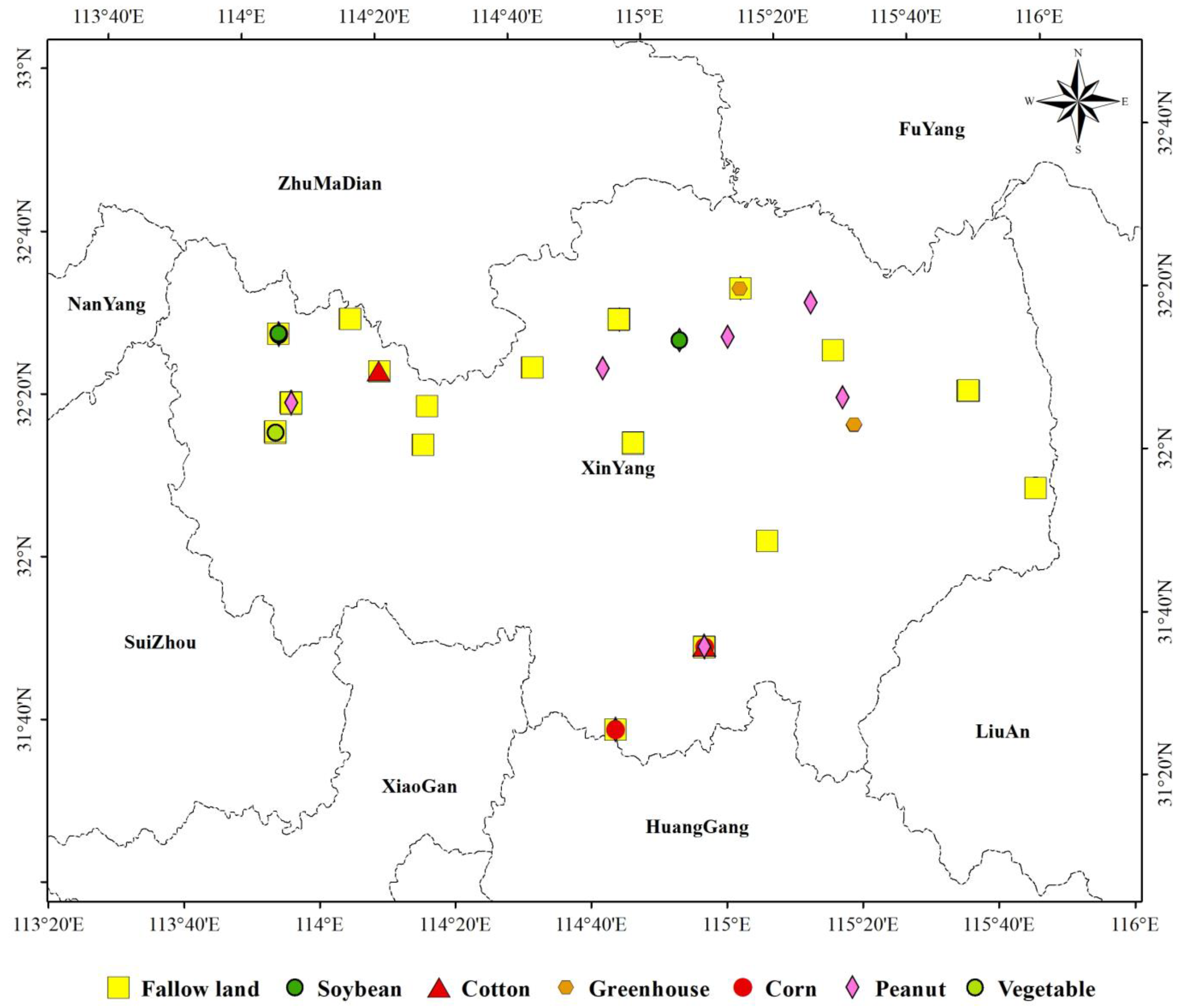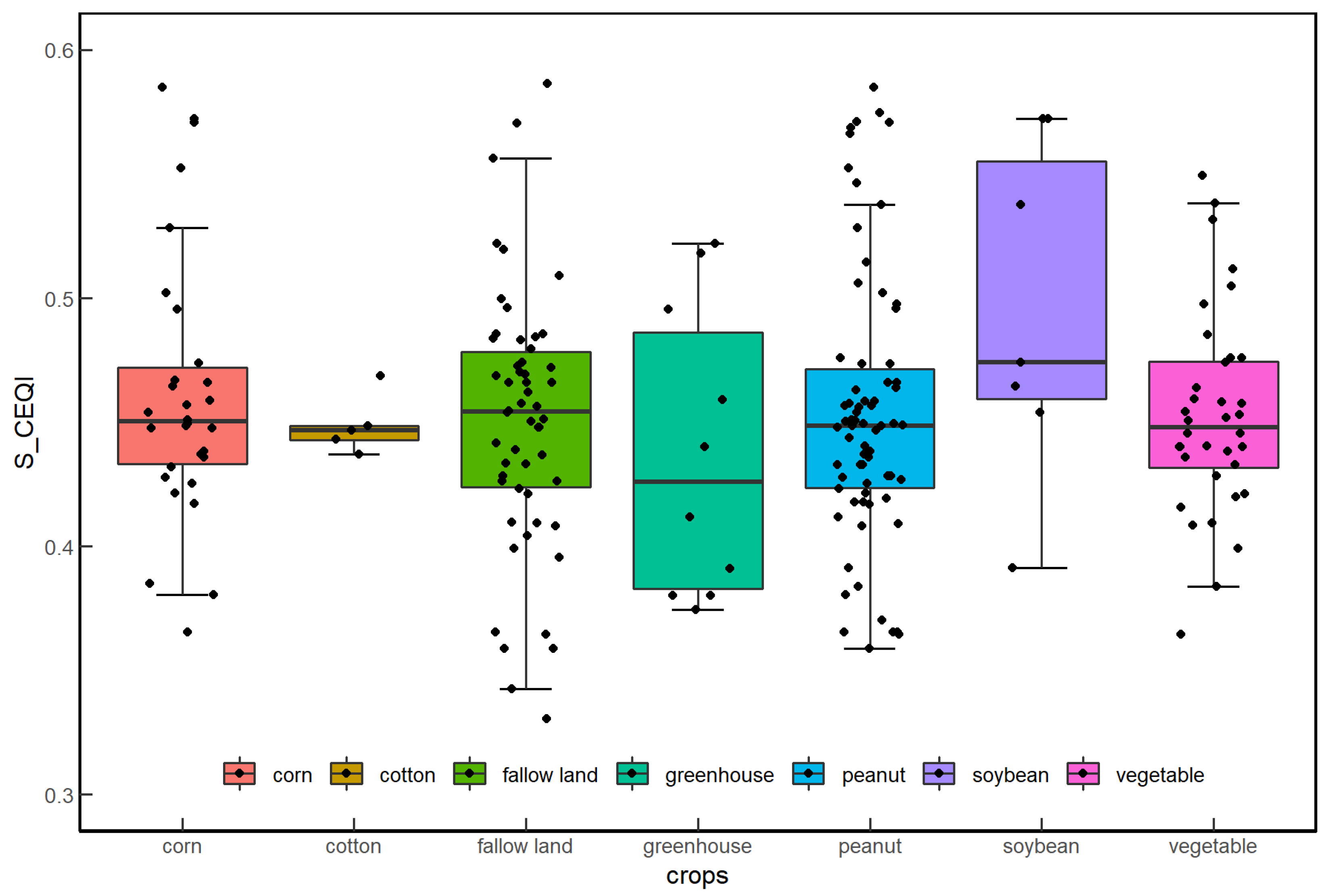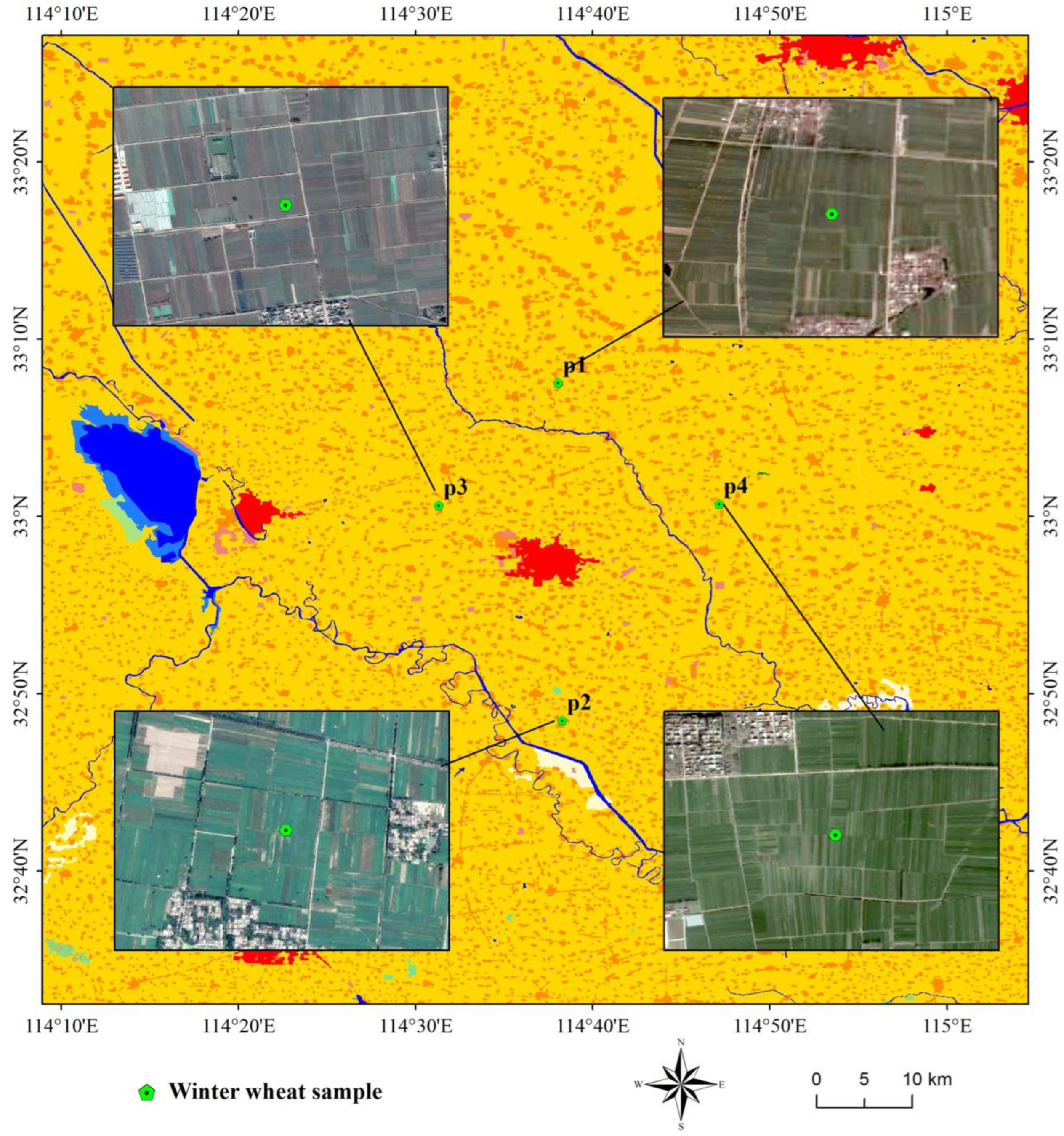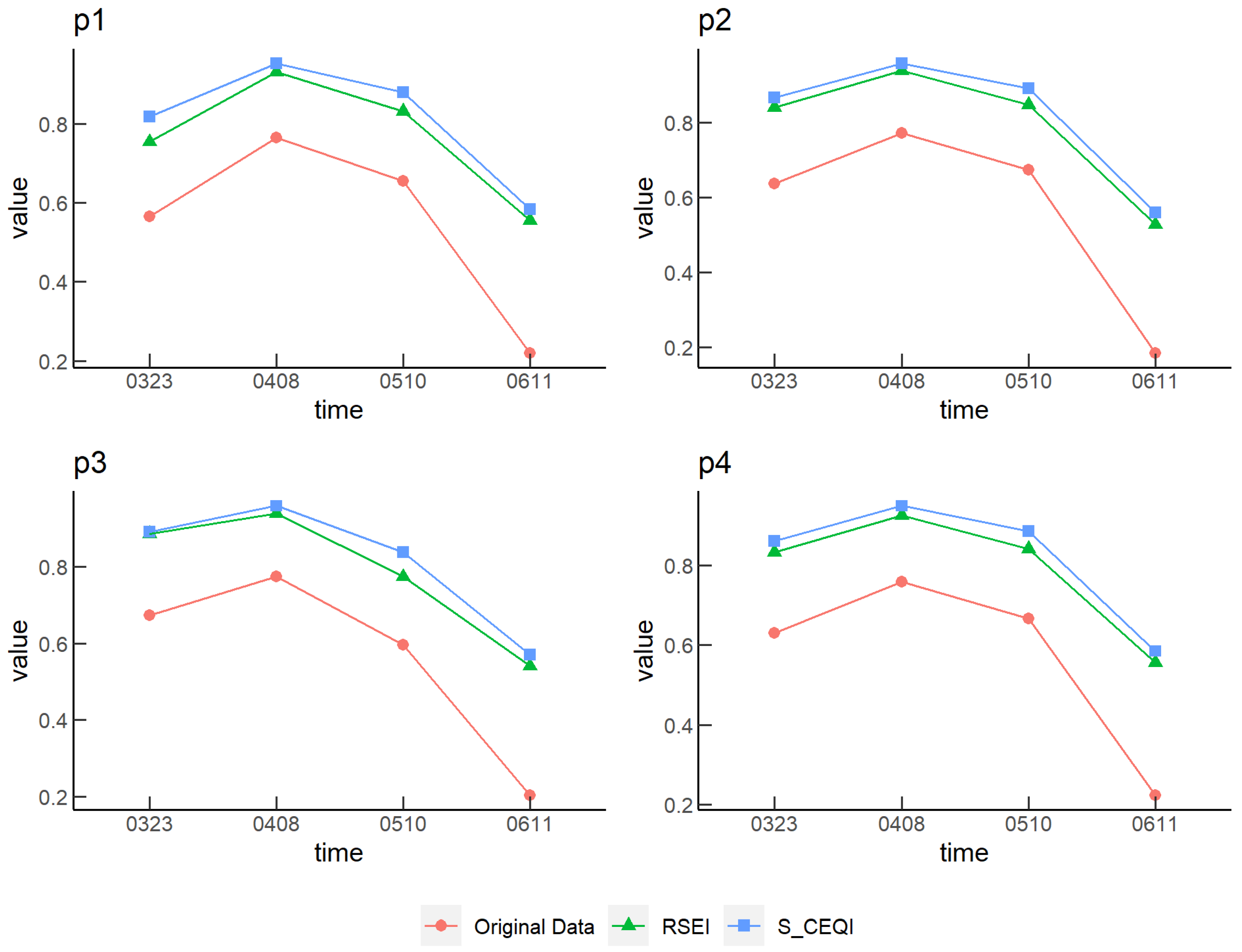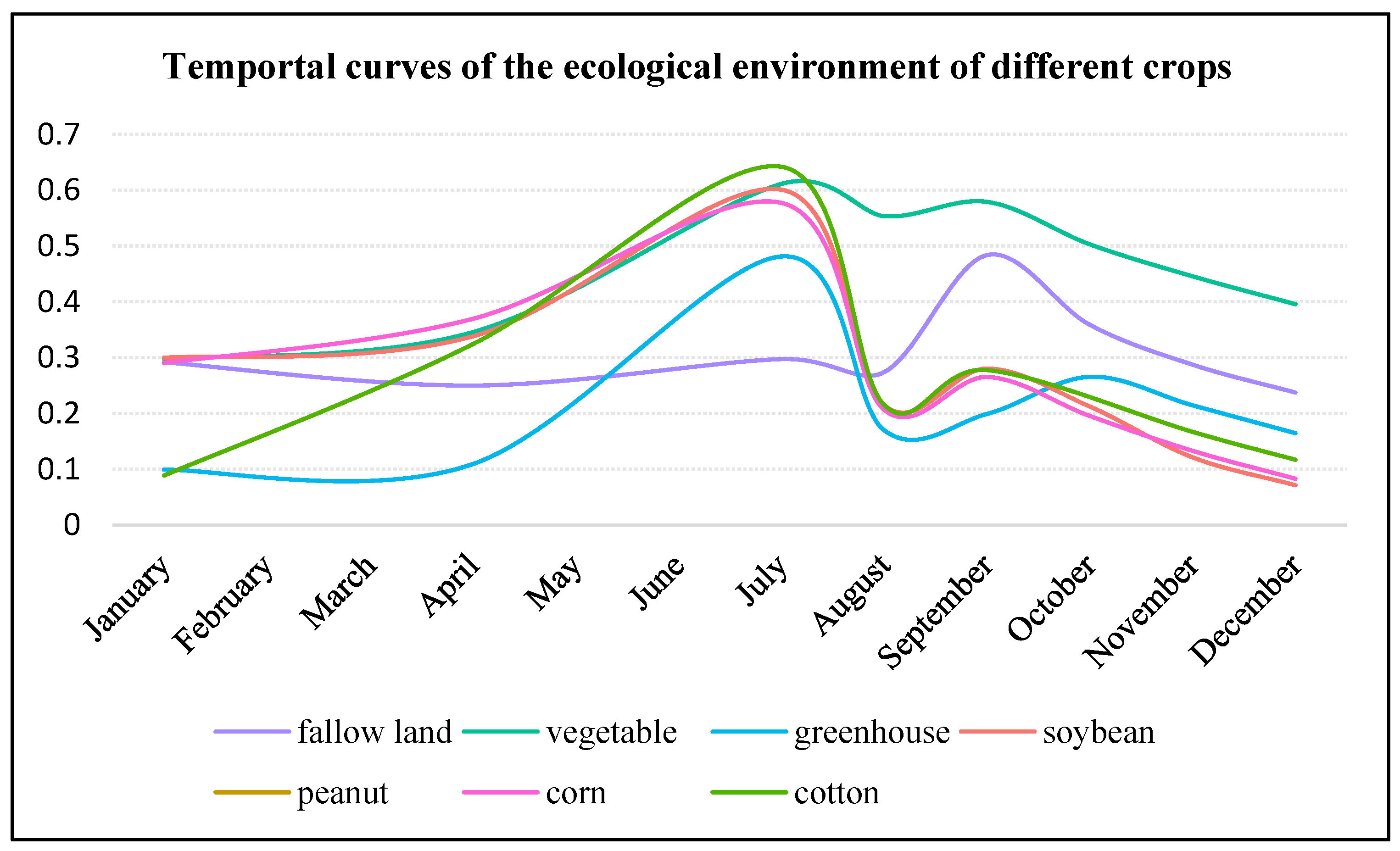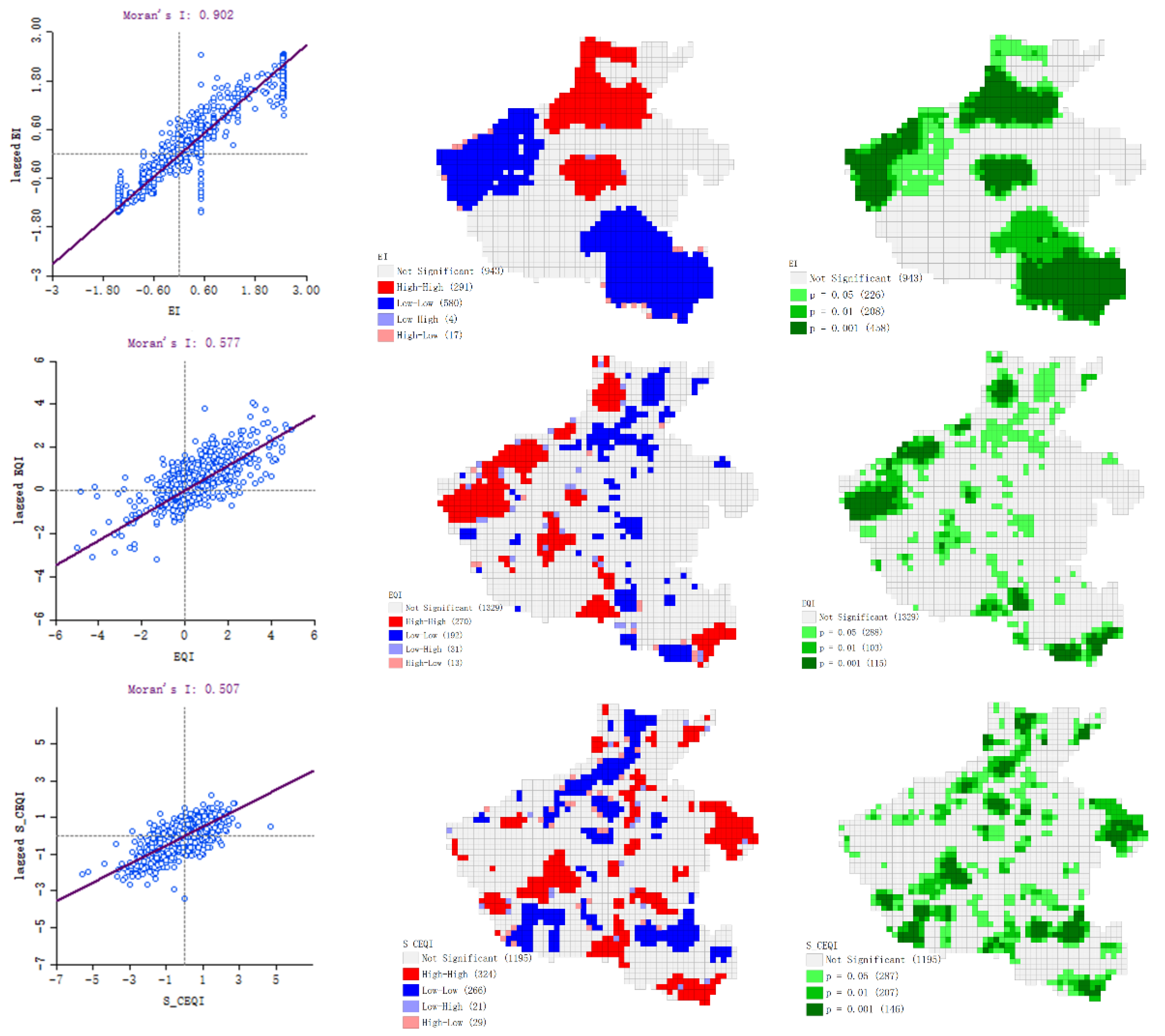1. Introduction
According to the 6th IPCC Assessment Report, the global average temperature would increase 1.5 degrees Celsius by the early 2030s under the current emission scenario [
1], which would have important impacts on ecological environment. The influence of human activities also results in complicated and multi-dimensional changes of ecological environment [
2]. The United Nations has proposed the Millennium Ecosystem Assessment Plan [
3], 2030 Sustainable Development Goals [
4], and the initiative Decade of Ecosystem Restoration [
5] aiming at a multi-level and comprehensive assessment of the global ecosystem. Therefore, it is necessary to integrate ecological big data of multi-source and multi-scale to carry the quantitative research of time-intensive and spatial-refined on the comprehensive ecological environmental quality assessment. The development of remote sensing and cloud computing technologies provides the possibility for the evaluation. How to build an ecological environment quality evaluation model suitable for remote sensing big data to carry out comprehensive ecological environment research in large areas, long time series, and intensive time intervals is the focus of this paper.
At present, the quantitative ecological environment quality measurement models are (1) a single proxy index such as vegetation cover change [
6,
7,
8], heat island effect [
9,
10], landscape pattern index [
11,
12], ecological service value [
13,
14,
15,
16,
17], ecological contribution rate [
18], carbon emission [
10], normalized vegetation index (
NDVI) [
19,
20], enhanced vegetation index [
21], and net primary productivity of vegetation [
22], (2) ecological index (
EI) model in The Technical Specification of Ecological Environmental Status Assessment (HJ 192–2015) [
23] issued by the Ministry of Ecology and Environmental Protection of China, (3)the eco-environmental quality index (
EQI) proposed by Li Xiaowen, which is based on high-resolution land use/land cover data and the corresponding weight [
24] to measure the eco-environmental quality, (4) the remote sensing ecological environment index (
RSEI) [
25,
26] proposed by Xu Hanqiu calculate the eco-environment index-based remote-sensing image, (5) the improved models of
RSEI such as the improvement of
RSEI for time series analysis [
27], the improvement of
RSEI for the instability [
28], the RO-RSEI which is the improvement for the ecological indicators [
29], the ARSEI which is the improvement for the ecological indicators [
30].
Although the current models for quantitatively measuring the regional ecological environmental quality can reflect the regional ecological environment status, they can hardly reflect the spatial heterogeneity of the ecological environment objectively. The proxy indices could only reflect one aspect of the ecological environment and are not enough to represent the comprehensive ecological environment. The
EI and
EQI models rely on LUCC data whose accuracy of the secondary land use classification is not high enough [
31]. In addition, the weight corresponding to the land use type is subjective and fixed so that it could not distinguish the spatial differentiation of the ecological environment of the same land use type. What’s more, the recalculation time period of the two models is relatively long due to the limitation of the temporal resolution of the LUCC data source. The
RSEI is the most popular and widely used remote sensing ecological environment model due to the easy access to indicators that can be obtained through the remote sensing images with medium to high resolution. However, it also has some problems such as (1) static non-depersonalization method leads to the research area of the model could not exceed the scene of the image, and the results of different-phase images could not be compared effectively, (2) the model is unstable result from the PCA index aggregation method who would obtain two opposite results randomly, (3) using
RSEI result of a single image to represent the regional annual ecological environment status ignores the phenological characteristics of vegetation. Although the improved models of
RSEI have optimized the model, so far, there is still no quantitative ecological environment measurement model that can use remote sensing big data to carry out research on large areas, long time series, and intensive time intervals.
With the deepening and perfection of research on eco-environment, the evaluation method of ecological environmental quality has shifted from the traditional simple and single estimation to spatiotemporal dynamic assessment. In this paper, we constructed a new comprehensive remote sensing ecological environment quality index model SCEQI with spatial and temporal characteristics by improving the data source, dimensionless method, index aggregation method of RSEI and adding the multi-temporal mean value method. Remote sensing big data makes the model possible to conduct intensive time interval research, the full sequence dimensionless method enables the model to carry large-scale and long-term time-series research, and automated index aggregation method solves the problem of model instability and enables the model to perform batch calculations automatically. The multi-temporal mean value method solves the contingency problem result from the result of single image. It is more convincing and credible to use the average value of the calculation results of multi-temporal images in one year to represent the ecological environment state in that year than a single image. Finally, taking Henan Province as an example, we compared the results of the EI, EQI, RSEI, and SCEQI, to verify the temporal and spatial superiority of SCEQI through profile analysis and sample point analysis. In terms of space, the model can well distinguish the spatial heterogeneity of the ecological environment index between different ecosystems and the same ecosystem; in terms of time, the model can express the ecological environment differences of plants in different phenological stages.
3. Results
3.1. Results of EI Model
The
EI model was issued by the Ministry of Ecology and Environmental Protection of China aimed at evaluating the ecological status of administrative regions. It uses land use/cover secondary classification data, statistical data of administrative divisions, and remote images to obtain biological abundance, vegetation cover, water network density, land stress, pollution load, and environmental restriction indicators. These indicators are weighed and summed according to the corresponding weights in Regulations. Due to the lack of pollutant data in 1995 and 2000, in this study, we only calculated the
EI index from 2005–2019. The results of the
EI model are divided into different levels according to the grade range in Regulations. The results are shown in
Figure 4.
The EI results showed that the ecological environmental quality of the Henan Province was mediocre and there were obvious geographical differences in the spatial distribution. The ecological environment of mountainous areas in the west was obviously better than that of plains in the Middle East. Zones with better ecological environmental quality were concentrated in TaiHang, FuNiu, TongBai, and DaBie Mountains. In terms of administrative regions, the ecological environment of SanMenXia, LuoyYang, and JiYuan Cities was generally better than that of other regions. The ecological environment of XinYang City deteriorated in 2015 and 2019, and the ecological level changed from good to medium.
Overall, EI could reflect the overall ecological environment of different administrative units and their changes. However, it requires statistical data on atmosphere, water, and air particulate matter, which are difficult to obtain. The spatial statistical unit of the model is usually an administrative division of a city/county, and the statistical time unit is year, which not only limits the time scale but also the space scale of research.
3.2. Results of EQI Model
The
EQI model takes land use patches as the study unit and assigns the weight of secondary land use/cover type using the expert evaluation method to establish quantitative relationship between the land use type and ecological environment. We calculated the
EQI of Henan Province in six periods according to previous studies [
24]. The results are shown in
Figure 5.
The results of EQI model revealed noticeable geographical differences in the spatial distribution of ecological environmental quality in the Henan Province. The ecological environment of the TaiHang Mountains in the north, TongBai and DaBie Mountains in the south, and FuNiu Mountains in the west of the study area were noticeably better than that of the Huang-Huai-Hai Plain in the middle of the study area and NanYang Basin. Areas with high EQI values were concentrated in forest ecosystems and those with low EQI values were concentrated in the construction land and bare land ecosystems.
In conclusion, the EQI model used land use/land cover data to evaluate the ecological environmental quality, which breaks the restrictions of administrative divisions and ensures geographical continuity of the study area to a certain extent. It can also reflect the differences in ecological environment of different ecosystems objectively within the study area. However, the ecological weight of ecosystems in the model is set subjectively and it is difficult to express spatial heterogeneity of the same ecosystem due to the fixed weight.
3.3. Results of RSEI Model
RSEI is a model that uses four indices,
NDVI,
NDBSI,
Wet, and
Lst, calculated using a single remote sensing image in October to measure the annual regional annual ecological environment status. Due to the availability of data sources and objectivity of models,
RSEI has been the most popular and widely used quantitative ecological and environmental quality model, and the
RSEI results of Henan are shown in
Figure 6.
Due to the influence of clouds, the images in October could not cover the entire study area; thus, there were large blanks in the calculation results and the calculation results of adjacent images had obvious boundaries. It proved that RSEI model was not suitable for a large study area. From the existing RSEI results, we could still roughly find that the ecological environmental status of western mountainous areas and border areas of the north and south of the Henan Province was better than that of central plains. However, the results showed no obvious difference between the cultivated land ecosystem and construction land ecosystem. This was because the main crops cultivated in Henan Province were wheat and corn in winter and summer, respectively. Winter wheat was harvested in October, while at the time, summer corn was still a seedling. The ecological environmental quality of cultivated land was the lowest in October throughout the year. Thus, it was unreasonable for the RSEI model to use a single scene image to measure the annual ecological environmental quality ignoring the phenological characteristics of plants.
3.4. Results of SCEQI Model
This study improved the data sources, dimensionless method, and index aggregation methods and introduced the multi-temporal average method to build
SCEQI. It could overcome the limitation of area size and considered the phenological characteristics of plants. It is more objective and accurate to use the annual/seasonal/monthly average method to evaluate the regional annual/seasonal/monthly ecological environmental state. Moreover, due to improvement of the dimensionless method, the long-term sequence ecological environment evaluation was more objective and accurate. The
SCEQI model calculated the annual/seasonal/monthly ecological environment quality index based on all good quality images and pixels throughout the year/season/month and then took the average of each pixel value as the final comprehensive ecological environmental quality index. The results are shown in
Figure 7.
The SCEQI results showed obvious geographical differences in the spatial distribution of ecological environmental status in the Henan Province. The high value zones of eco-environment quality index were distributed in mountainous and hilly areas such as the TaiHang Mountains in the north, TongBai and DaBie Mountains in the south, and Funiu Mountains in the west of the study area. The ecological environmental quality of plain area was deteriorated compared to that of mountainous and hilly areas, and the ecological environmental quality of urban construction land was the worst. However, the results of EI and EQI were different from those of SCEQI, and they did not exhibit obvious low and high value clusters in the Henan Province. This is because SCEQI considered all phenological periods of vegetation comprehensively and expressed ecological differences in different regions in the form of mean values. There was a large amount of cultivated land in the middle and eastern parts of the Henan Province where the main crop was winter wheat. The ecological value of winter wheat in winter was much higher than that of deciduous broad-leaved forests of mountains to the west and along the northern and southern boundaries of study area. The multi-temporal averaging method averages the values of different seasons and neutralizes the ecological gap between two land types according to the actual situation of different periods.
3.5. Analysis of Results
3.5.1. Consistency Analysis
According to the spatial distribution characteristics of ecological environmental quality calculated using the four models,
EI (
Figure 4),
EQI (
Figure 5),
RSEI (
Figure 6), and
SCEQI (
Figure 7) had the same spatial characteristics. They all proved that the ecological status was better in the west and northern and southern edge mountains and worse in the east and center and eastern plain areas.
Due to the absence of
RSEI results in large areas, we ignored
RSEI model in the overall comparison. Although the coupling variables of
SCEQI and
EI were different, the calculation results of
SCEQI were numerically closer to those of
EI (
Table 5). Compared to
EI results, the absolute maximum and minimum deviations of
SCEQI and
EI were 0.021 and 0.006, respectively, and the maximum and minimum deviations of
EQI and
EI were 0.124 and 0.062, respectively. The average offset of
EQI was 7.236 times that of
SCEQI. According to the profile in
Section 3.5.2, the results calculated using the
EQI model were significantly higher than those of
EI and
SCEQI in the deciduous broad-leaved forest ecosystem, mixed coniferous and broad-leaved forest ecosystem, and evergreen coniferous forest ecosystem (mainly bamboo forest) but lower than those of
EI and
SCEQI in the cultivated land ecosystem. This indicated that the
EQI model overestimated the environmental quality of woodland ecosystems and underestimated the environmental quality of cultivated land ecosystems.
3.5.2. Spatial Accuracy Analysis
Spatial Resolution Analysis
A 10 km × 10 km sample was selected to compare the spatial resolution of the four models. The result (
Figure 8) shows that the spatial resolution of the four models showed
SCEQI =
RSEI >
EQI >
EI. The
EI result of the sample was a constant value without any fluctuation. The
EQI result was either 0.2 or 0.4 with no continuous fluctuation that violates the geospatial continuity. Although the spatial resolution of
RSEI was as high as
SCEQI and its result was continuous spatially, its result appeared large gaps caused by the single image. It is clear that the
SCEQI model performs best, and the results are complete, continuous and fine spatially.
Profile Analysis
To compare differences in the results of different ecosystems under different models, this study selected the profile line (
Figure 9) of transition zone from the forest to cultivated land for analysis. From the west to east, the types of ecosystems were deciduous broad-leaved forest, mixed coniferous and broad-leaved forest, evergreen coniferous forest, and cultivated land. The results of the profile using different models are shown in
Figure 10.
The results of all four models proved that the ecological status in the west (forest ecosystem) was better than those in the east (arable land ecosystem); however, there were significant differences in the results of different models. Due to different data sources and mechanisms of the four models, the EQI results were quite different in the local spatial distribution. The EI model considers the administrative division as the research unit and spatial accuracy as size of the administrative unit. The EQI model considers the land use patch as the study unit and the spatial accuracy was equal to the size of land use patch. RSEI and SCEQI used the remote sensing image pixel as the calculation unit; thus, spatial resolution was the size of the remote sensing image pixel, which was 30 m in the study.
The measurement results of EI and EQI revealed extreme fluctuations in space due to limitation of the rough study unit. However, the profile curves of RSEI and SCEQI were continuous and smooth in space, attributed to the fine research unit. The ecological environment is a continuous, gradual, and dynamic process, and it should not have sudden changes such as “cliff” in space. Obviously, the ecological environmental quality measured using RSEI and SCEQI was more refined, and it could reflect the spatial heterogeneity of ecological environment of the same ecosystem. For example, the density of deciduous broad-leaved forests, leaf area index, tree species, and different crops had different ecological values. However, the results of RSEI and SCEQI were also quite different. The RSEI values of forest ecosystem were significantly higher than those of SCEQI while the RSEI values of arable land were significantly lower than those of SCEQI. This is because SCEQI replaces the value of a certain phase in October in RSEI with the average of all phases of the year. The EQI of a single image can only represent the ecological environment state at the time of taking the image, and it is unreliable to represent the annual ecological environment state. Thus, in this study, RSEI significantly overestimated the ecological value of forest ecosystems and underestimated the ecological value of cultivated land ecosystems. The results of SCEQI apears more objective and credible.
Sample Analysis
Considering cultivated land ecosystem as an example, this study selected a total of 219 points of seven crops, namely corn, soybean, cotton, greenhouse, peanut, vegetable, and fallow, to study the interpretation degree of differences in the ecological environment of the same ecosystem using the four models. The sample points consisted of 8 soybeans, 73 peanuts, 5 cotton, 36 vegetables, 9 greenhouses, 57 fallow lands, and 31 corns (
Figure 11). All samples were distributed in Xinyang City, Henan Province, and all crops except greenhouses (winter fallow) were single-season crops.
Using the four models, we calculated
EQIs of the 219 points as well as the Max, Min, Mean, Standard Deviation, and Variance. Statistical results (
Table 6) revealed that the
EI values of all 219 plots were 0.59 and
EQI values were 0.25, without any fluctuations. The values of
RSEI and
SCEQI were relatively discrete. Further, the maximum value, minimum value, mean value, and standard deviation of
RSEI were 0.67, 0.19, 0.41, and 0.17, respectively, and those of
SCEQI were 0.62, 0.28, 0.46, and 0.06, respectively. The standard deviation of
RSEI was larger than that of
SCEQI, indicating that the ecological environmental index of crops in October fluctuated more than the annual average.
These differences reflect the different operating mechanisms of the models. The
EI model used the administrative unit as the measurement unit, and the 219 plots were all located in Xinyang City, Henan Province (
Figure 11). Therefore, the
EI value of the same administrative region is a fixed value that cannot distinguish the differences in the ecological environmental status of samples (different crops of the same ecosystem). The
EQI model considers secondary land use patch as the research unit, and the 219 samples were all dry lands of the same ecosystem. According to the expert scoring result, the ecological environmental quality of dry land was 0.25; thus,
EQI values of the 219 samples were constant (0.25), which could not distinguish the ecological differences of different crops. However,
RSEI and
SCEQI take the pixel of image as the research unit whose spatial scale was fine enough to break the spatial restrictions of administrative divisions and land use patches.
As
RSEI reflects the ecological environment at a certain moment, this study used the results of
SCEQI model to study the differences in
EQI of different crops. This study used boxplots (
Figure 12) to explore the distribution characteristics and dispersion of
EQI of different crop types. The average level and fluctuation degree of
EQI of different crops were different. The median values of peanuts, cotton, vegetables, fallow lands, and corn were relatively close, but the median value of soybeans was significantly higher and the median value of greenhouses was significantly lower. The
EQIs of different crops fluctuated at different degrees. The fluctuation degrees of soybean and greenhouse were noticeably larger than those of other crops. The
EQIs of the same crops were also quite different due to influence of factors such as location, nature environment, and human activities, and
SCEQI could accurately express such differences.
3.5.3. Precision Analysis of RSEI and SCEQI
Both
RSEI and
SCEQI exhibited high spatial accuracy and ensured continuity of geographical space, and they could express the ecological environmental quality of geographical space scientifically. Due to differences in data sources,
RSEI adopted the static dimensionless method while
SCEQI used the dynamic dimensionless method. We selected four winter wheat samples (
Figure 13) and calculated the
EQI of different phenological stages using
RSEI and
SCEQI, respectively, to compare the accuracy of the model. In this study, we compared four phenological stages of winter wheat, the jointing (23 August 2018), heading (8 April 2018), grain filling (10 May 2018), and maturity stages (11 June 2018).
The results are shown in
Figure 14. The original data indicated the data before dimensionalization,
RSEI is the result of static dimensionless, and
SCEQI is the result of full-sequence dimensionless. The time series trend of the result of static dimensionless and dynamic dimensionless of p1, p2, p3, and p4 was consistent with the original data, and the information on original data was well preserved. Thus, the static and dynamic dimensionless method could preserve incremental information of the same point at different times. However, as seen from
Table 7, the original data of p1 on May 10 and p4 on March 23 were 0.656 and 0.629, respectively, and the corresponding static dimensionless results were 0.831 and 0.832; evidently, the relative magnitude between the two values changed after static dimensionless. The original data of p1 on May 10, which was greater than that of p4 on March 23, was smaller than that of p4 on March 23 after static dimensionless. However,
SCEQI using full-sequence dimensionless method did not have such errors. It not only saved the incremental information of the same point at different times but also saved the incremental information between different points at different times.
3.5.4. Temporal Resolution Analysis
Temporal accuracy depends on the repetition period of data source of the model. Land use data was the main data source of
EI and
EQI models. However, currently, the land use data is usually updated annually or every 5 years. Therefore, the minimum time interval for recalculation of
EI and
EQI was 1 year. Thus, the
EI and
EQI models with annual recalculation could not estimate the ecological status and pixel changes in a year. Different from
EI and
EQI, remote sensing images with a short time cycle were the data source for
RSEI and
SCEQI models. In this study, the
RSEI and
SCEQI models used the Landsat satellite remote sensing images, whose revisit period was 16 days, to evaluate the regional ecological quality index; thus, the highest time accuracy of
SCEQI and
RSEI model was 16 days.
RSEI is a static measurement model that uses a single image to evaluate the ecological environment status; thus, its results are static and cannot estimate changes in the ecological status. However, the
SCEQI model used remote sensing big data and dynamic dimensionless method to accurately measure the continuous ecological environment changes. To verify the temporal characteristics of
SCEQI model, the 219 samples were re-used to calculate the monthly average value of each crop to compare temporal differences of the eco-environment, and the results are shown in
Figure 15.
The time series curves of EQIs of the seven crops were quite different due to different phenological characteristics. The time curves of ecological environmental quality index of corn, peanut, soybean, and cotton had similar phenological characteristics and changed trend. They were all planted in April and harvested in August. The ecological environmental quality indices of these crops reached the peak in July, proving that the ecological status was the best in July. The sharp decrease in August was attributed to human harvesting activities. The EQI of greenhouses reached two peaks in August and October, attributed to plantation of some off-season crops in winter (after October). The fallow land was dominated by grass that grows best in September; thus, its ecological environmental quality index reached the peak in September. Vegetables are a cash crop significantly affected by human activities. Its EQI was high due to economic reasons, and its curve also had double peaks. Thus, the ecological environment status of different crops was closely related to their phenological characteristics. The ecological environmental quality of different crops in the same period as well as the ecological environmental quality of the same crops in different periods were different.
In conclusion, the eco-environmental quality curves of different crops verified that the eco-environmental quality status of vegetation in different phenological stages was different, which proved that SCEQI model could evaluate regional eco-environmental status objectively by comprehensively considering each phenological characteristic of vegetation. The model also exhibited fine time accuracy.
3.5.5. Compare Analysis of Globe Spatial Autocorrelation of Change of Ecological Environment Index
Moran scatter plots of the change of ecological environment index of Henan Province from 1995 to 2019 (
EI was from 2005 to 2019) are shown in
Figure 16. The high-high (HH), low-low (LL), low-ligh (LH), and high-low (HL) demonstrated significant spatial agglomerations. Because the result of
RSEI was spatially incomplete, we only calculated the Moran’s Is of
EI,
EQI and
SCEQI. The Moran’s Is were 0.902, 0.577 and 0.507, respectively, indicating the change of ecological environment index has obvious agglomeration in space. However, the spatial aggregation results of the three models are quite different. The Moran’s I was unusually large, and the significant aggregations were also too concentrated as a result from the roughness calculation unit of the
EI. The cluster map of
EQI showed that most of HH aggregations were distributed in the mountains and hilly areas were dominated by forest ecosystem, and most LL aggregations occurred in the plains where the main ecosystem was arable. Obviously, these aggregations relying on the ecosystem were not convincing. Different from
EI and
EQI, both HH and LL clusters of
SCEQI were distributed in plains and Nanyang Basin where had strong human activities, what is consistent with objective fact that human activities have a significant impact on the ecological environment. This also proved that the
SCEQI model was the most reliable.
4. Discussion
Ecological environment is the combined result of natural factors, social factors, economic factors, disasters, anthropogenic activities, and so on. It is a challenge to monitor the spatiotemporal changes of regional ecological status dynamically. In this study, we constructed a regional comprehensive eco-environmental quality index model (SCEQI) with spatiotemporal characteristics and compared its results with other models(EI, EQI, RSEI). The results showed that this model is superior to the other three models in terms of space, time and accuracy.
In the past, there was almost no long-term and continuous research of ecological environment evaluation, and most of their time intervals were 1 year, 5 years or longer. So, we attempted to carry out intensive time-interval ecological environment studies by replacing the data source with remote sensing big data who has the characteristics of long time series and short period. However, remote sensing big data also puts forward requirements for the stability, accuracy, and intelligence of the model. Because the remote sensing images of different rows and columns have different spatiotemporal information.
Therefore, establishing the association among different spatio-temporal images is the key to using remote sensing big data sources. In this study, the full sequence dimensionless method was used to achieve it. The full-sequence dimensionless method can effectively use each good quality pixel, which greatly reduces the influence of cloud. Besides, the spatial association enables the model to be applied in large areas which RSEI could not.
As a data source, remote sensing big data needs to be calculated in batches, which requires the model to be stable and intelligent. Therefore, we corrected the unstable factors of the index aggregation method in
RSEI. The principal component analysis method is to assign weight to the ecological indicators according to their loads (contributions) in the first principal component (
PC1). However, because each
PC1 has two opposite eigen vectors, resulting in two opposite results. And these two opposite results happen randomly in the aggregation of indices. Our previous studies have shown that the direction of indicators having a positive effect on the ecological environment is always the same, the directions of indicators having a negative effect on the ecological environment are always the same, and the directions of positive indicators are always opposite to the negative ones in the eigenvectors of
PC1 [
28]. Based on the above-mentioned rules and the rule that
NDVI always had a positive effect on the ecological environment, we fixed the weight of each indicator according to the direction of the eigen vector of
NDVI in
PC1. In fact, both
EI and
EQI models are subjective in setting the weight of ecological indices, and the weight of indicators has been controversial [
37,
38]. The automatic principal component index aggregation method is objective and repairs the instability of the model, making it possible to batch calculations with remote sensing big data.
Since remote sensing images are instantaneous, the calculation results of a single image are accidental. Using a single image to calculate the quality of ecological environment over a period is obviously not rigorous. The multi-temporal mean method was used in SCEQI to evaluate the ecological environment status and its changes in a certain period, for example, the annual, quarterly, and monthly, and the result showed to be objective and convincing.
All the four models could measure the regional ecological environmental quality and its changes to a certain extent. In this study, the measurement results of the four models were generally consistent. The
SCEQI model was more precise than other models in spatial resolution, temporal resolution, and precision. However, there are still some uncertainties in the model, such as the impact of clouds. Although the full sequence dimensionless method can maximize the use of high-quality pixels in the image, the accuracy of the model results for those pixels that are frequently covered by clouds in the time series will also be affected. The multi-temporal mean method can reduce this uncertainty, but it cannot avoid it. Future research can interpolate or replace cloud data with other data sources to further improve the accuracy of the model. Besides, the ecological environment indices were still not rich enough. The ecological environmental quality status is the comprehensive result of direct and indirect interactions of many factors. The trial version of ‘Technical Specifications for Evaluation of Ecological Environment Status’ issued by the Ministry of Environmental Protection of China in 2006 and the updated published version in 2015 both considered the impact of air pollutants on the ecological environment. Moreover, the 2015 version added more air pollutants to the
EI model, which proved that air quality is an important indicator of the ecological environment. Additionally, anthropogenic activities [
39,
40], topography [
6], climate [
41], population economy [
41], and other factors have an increasingly significant impact on the ecological environment. Therefore, future studies should consider more complex ecological environment influencing factors to characterize the regional ecological environmental quality more objectively and accurately.
5. Conclusions
By analyzing the problems in the existing quantitative eco-environmental quality index model, we constructed an eco-environmental quality index model with spatiotemporal characteristics (SCEQI) by improving the data source, dimensionless method, index aggregation method of RSEI, and introduced the multi-temporal mean method to the model. We verified the reliability, spatial accuracy and temporal accuracy of SCEQI by comparing it with several popular quantitative models (EI, EQI, and RSEI). The main conclusions were as follows:
- (1)
The spatial distribution of the four models were consistent, indicating the SCEQI proposed in this study was reasonable.
- (2)
The resolution of SCEQI model was finest among the four models. Both profile analysis and sample analysis proved SCEQI could not only express the geographic spatial differences of ecological environment between different ecosystems but also that between the same ecosystems, which other models could not achieve.
- (3)
The SCEQI model broke the limitations of the study area and research time due to the improvement of the full-sequence dimensionless method who could establish an effective association of different spatio-temporal images.
- (4)
The SCEQI could carry out ecological environment research of long time series and dense time intervals due to the improvement of remote sensing big data. The curves of SCEQI of different crops demonstrated obvious differences among different phenological stages, indicating SCEQI has fine temporal resolution.
- (5)
Compare analysis of globe spatial autocorrelation of the change of ecological environment index showed that only the results of SCEQI were consistent with the fact that human activities have a significant impact on the ecological environment, which once again verified the precision of the model.
The SCEQI model could obtain regional ecological environment status timely, accurately, and dynamically, attributing to the improvement of data source and methods. It can not only provide objective and accurate data support for policy-making departments but also contribute to advancing the Sustainable Development Goals (SDGs). However, ecological environment is a complex system with many influencing factors. And this paper focused on the improvement of the method without the discussion of the influencing factors. Therefore, the indicator system and driving mechanism of ecological environment should be studied according to regional characteristics in future research.
